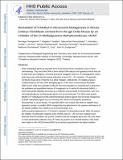| dc.contributor.author | Thongararm, Pennapa | |
| dc.contributor.author | Fedeles, Bogdan I. | |
| dc.contributor.author | Khumsubdee, Sakunchai | |
| dc.contributor.author | Armijo, Amanda L. | |
| dc.contributor.author | Croy, Robert G. | |
| dc.contributor.author | Essigmann, John M. | |
| dc.date.accessioned | 2020-04-22T16:25:37Z | |
| dc.date.available | 2020-04-22T16:25:37Z | |
| dc.date.issued | 2019-12-16 | |
| dc.identifier.issn | 0893-228X | |
| dc.identifier.issn | 1520-5010 | |
| dc.identifier.uri | https://hdl.handle.net/1721.1/124796 | |
| dc.description.abstract | DNA methylating agents are abundant in the environment and are sometimes used in cancer chemotherapy. They react with DNA to form methyl-DNA adducts and byproduct lesions that can be both toxic and mutagenic. Foremost among the mutagenic lesions is O6-methylguanine (m6G), which base pairs with thymine during replication to cause GC → AT mutations. The gpt delta C57BL/6J mouse strain of Nohmi et al. (Mol. Mutagen 1996, 28, 465-70) reliably produces mutational spectra of many DNA damaging agents. In this work, mouse embryo fibroblasts (MEFs) were made from gpt delta C57BL/6J mice and evaluated as a screening tool to determine the qualitative and quantitative features of mutagenesis by N-methyl-N-nitrosourea (MNU), a direct-acting DNA alkylator that serves as a model for environmental N-nitrosamines, such as N-nitrosodimethylamine and therapeutic agents such as Temozolomide. The DNA repair protein MGMT (O6-methylguanine DNA methyltransferase) protects against environmental mutagenesis by DNA methylating agents and, by removing m6G, limits the therapeutic potential of Temozolomide in cancer therapy. The gpt delta MEFs were treated with MNU to establish dose-dependent toxicity. In parallel, MNU mutagenicity was determined in the presence and absence of the MGMT inhibitor AA-CW236 (4-(2-(5-(chloromethyl)-4-(4-(trifluoromethoxy)phenyl)-1H-1,2,3-triazol-1-yl)ethyl)-3,5-dimethylisoxazole). With and without the inhibitor, the principal mutagenic event of MNU was GC → AT, but more mutations were observed when the inhibitor was present. Evidence that the mutagenic lesion was m6G was based on mass spectral data collected using O6-methyl-d3-guanine as an internal standard; m6G levels were higher in AA-CW236 treated MEFs by an amount proportional to the higher mutation frequency seen in the same cells. This work establishes gpt delta MEFs as a versatile tool for probing mutagenesis by environmental and therapeutic agents and as a cell culture model in which chemical genetics can be used to determine the impact of DNA repair on biological responses to DNA damaging agents. | en_US |
| dc.description.sponsorship | National Institutes of Health (U.S.) (Grant P30 ES002109) | en_US |
| dc.description.sponsorship | National Institutes of Health (U.S.) (Grant R01 CA080024) | en_US |
| dc.description.sponsorship | National Institutes of Health (U.S.) (Grant P42 ES027707) | en_US |
| dc.description.sponsorship | National Institutes of Health (U.S.) (Grant T32 ES007020) | en_US |
| dc.language.iso | en | |
| dc.publisher | American Chemical Society (ACS) | en_US |
| dc.relation.isversionof | 10.1021/acs.chemrestox.9b00444 | en_US |
| dc.rights | Article is made available in accordance with the publisher's policy and may be subject to US copyright law. Please refer to the publisher's site for terms of use. | en_US |
| dc.source | PMC | en_US |
| dc.subject | Toxicology | en_US |
| dc.subject | General Medicine | en_US |
| dc.title | Modulation of N-Methyl-N-nitrosourea Mutagenesis in Mouse Embryo Fibroblasts Derived from the gpt Delta Mouse by an Inhibitor of the O6-Methylguanine Methyltransferase, MGMT | en_US |
| dc.type | Article | en_US |
| dc.identifier.citation | Thongararm, Pennapa et al. “Modulation of N-Methyl-N-nitrosourea Mutagenesis in Mouse Embryo Fibroblasts Derived from the gpt Delta Mouse by an Inhibitor of the O6-Methylguanine Methyltransferase, MGMT.” Chemical research in toxicology 33 (2020): 625-633 © 2020 The Author(s) | en_US |
| dc.contributor.department | Massachusetts Institute of Technology. Department of Biological Engineering | en_US |
| dc.contributor.department | Massachusetts Institute of Technology. Center for Environmental Health Sciences | en_US |
| dc.relation.journal | Chemical research in toxicology | en_US |
| dc.eprint.version | Author's final manuscript | en_US |
| dc.type.uri | http://purl.org/eprint/type/JournalArticle | en_US |
| eprint.status | http://purl.org/eprint/status/PeerReviewed | en_US |
| dc.date.updated | 2020-03-05T18:36:33Z | |
| dspace.date.submission | 2020-03-05T18:36:35Z | |
| mit.journal.volume | 33 | en_US |
| mit.journal.issue | 2 | en_US |
| mit.license | PUBLISHER_POLICY | |
| mit.metadata.status | Complete | |
